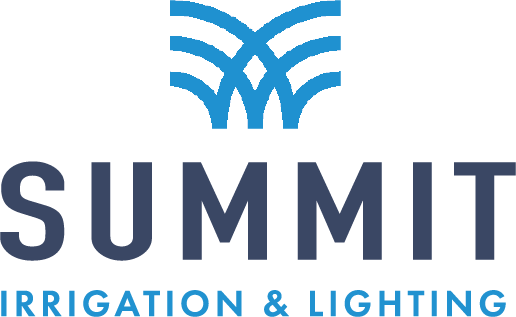Yes. Summit Irrigation & Lighting provides free written estimates. We will meet with you in person to discuss your specific irrigation needs and perform an on-site analysis to evaluate the size and layout of your property. It is critical for us to view your property in order to provide an accurate and honest estimate.
FREQUENTLY ASKED QUESTIONS
Irrigation
It is difficult to give you a price for a sprinkler system without meeting with you personally and reviewing your property’s watering needs. There are a number of variables that affect cost including the size of your property, the type of landscaping, water source (city, pump and well, or lake draw), and obstacles in the property including pools, sheds, fences, etc. We try to customize the system to maximize the benefits and coverage.
It depends upon several factors including the size of the system, the number of zones, the water source, the soil conditions and whether there are a lot of trees and shrubs in your yard. Typically, a small system can be installed in as little as a day while some larger systems can take a week or more. Most systems are completed in 2-3 days.
We take great care during the installation process to make sure there is as little disruption to your property as possible. We use a vibratory plow to install the lines. Pipe and wires are “pulled” underground through a small slit in the earth to minimize damage to the lawn. We also carefully hand dig in flower beds and around utility markings. After a couple of weeks from the installation date, the only visible signs of your new sprinkler system should be a greener lawn and healthier plants.
Absolutely. Our service department is fully staffed to include full-time office support as well as experienced service technicians. Our service department handles everything from starting your system in the spring to winterizing it in the fall, and everything in between. Providing superior, long-term service for our customers is the cornerstone of Gentle Rain and always will be.
Summit uses professional-grade equipment from the largest, most respected manufacturers in the industry including Hunter, Rainbird, Toro, and Netafim. We only use pipe that is certified by the National Sanitation Foundation (NSF) and the American Society for Testing and Materials (ASTM).
Basic maintenance is required to ensure the effective operation of your system. The most important services are the fall winterization and the spring start-up. In the fall, we shut down the system and blow out the lines to eliminate the risk of freezing pipes. In the spring, we turn the system back on, evaluate each zone, adjust heads and reset the controller.
An automatic sprinkler system typically uses less water than watering by hand or manual, hose-based sprinklers. Our systems are designed, installed and programmed to deliver even, precise watering, minimizing water loss due to run-off and evaporation.
We recommend installing a rain sensor on all of our sprinkler systems. The sensor is set to automatically shut off the system when the amount of rain reaches a certain level. Once an appropriate level of dryness is reached, the system will automatically restart.
The best time to water is in the early morning, with the watering completed before the sun comes up. At this time the water pressure is the highest, and evaporation and wind are the lowest. Try not to water in the evening, since having moisture on your grass and plants overnight can promote the growth of fungus.
Rotor heads are typically used for large turf areas. These sprinklers contain a gear-driven mechanism that rotates the head in a circular pattern. Spray heads are generally used in smaller flower beds and smaller grass areas. These sprinklers do not contain moving parts and emit a fan-type spray in a fixed pattern.
Drip irrigation is a highly-efficient, alternative method to watering planting beds. Drip irrigation lines are installed below the mulch and out of sight. Water is applied directly to the plant root zones via drip emitters placed at proper spacing intervals. Since there is no water spray, water loss from evaporation is virtually non-existent. We can help you decide whether this a good option for your planting beds.
This device prevents water from the irrigation system from “flowing backwards” into the drinking water supply. A backflow preventer is required for sprinkler systems. Our technicians are trained and certified to install these devices on irrigation systems.
Landscape Lighting
Yes. Summit Irrigation free written estimates. We will meet with you in person to discuss your specific lighting needs and perform an on-site analysis to evaluate the size and layout of your property. It is critical for us to view your property in order to provide an accurate and honest estimate.
It depends on several factors including the size of your property, the complexity of the landscape, the number and type of fixtures, and the placement of the fixtures.
Most systems take between one and three days to install, but every system is different. Time of installation is site dependent.
There is little or no disruption to your property. If trenching is required across the lawn, a small incision is made about 6-8 inches deep, the wire is placed inside, and the grass folded over top of it. In planting beds, the mulch is raked back and a similar small incision is made to bury the wire.
Our warranties include:
- One year guarantee on parts and labor
- Three year guarantee on light fixtures
- Lifetime warranty on transformers
Absolutely. Summit is fully staffed and equipped to service your landscape lighting system.
In addition to being safer and more energy efficient, low-voltage lighting systems provide much cleaner and sharper lighting that is impossible to achieve with high-voltage systems. low-voltage systems provide light to accentuate a given area subtly while high-voltage systems provide too much light at the source, drawing attention to the fixture and away from the area you are trying to light.
A professionally designed and installed lighting system uses components and techniques that are far superior to prepackaged kits. These kits cannot produce nearly the same quality of light or provide the same durability that a professional system can. The transformers are typically under-powered, and the fixtures are made of cheap plastic with too many low-wattage bulbs. Our fixtures are made of high-quality copper, brass and aluminum.
While solar-powered lights are certainly energy efficient and easy to install (i.e. no wires), there are several key disadvantages. The lighting is very dim compared to low-voltage lighting and the fixtures produce a bluish tint, creating the appearance of a poorly lit landing strip. Also, areas that are naturally shaded adversely affect the fixtures’ recharging capabilities.
There is a timer located inside the transformer that controls the lighting system. It is set to your desired on/off times and can be manually overridden with a flip of a switch.
Low-voltage lighting is extremely energy efficient. While the operating expense will vary based on the number of fixtures, 12-volt lamps consume approximately one third the electricity that 120-volt lamps use. Most systems can be operated for less than fifty cents a day.
Very little. Bulbs do burn out and need replacement, and the lenses need to be cleaned periodically. Also, as your landscape changes, you may need to adjust or move fixtures.
When properly designed and installed, low-voltage lighting systems are expandable, so they can be adapted to meet your needs today and tomorrow.

